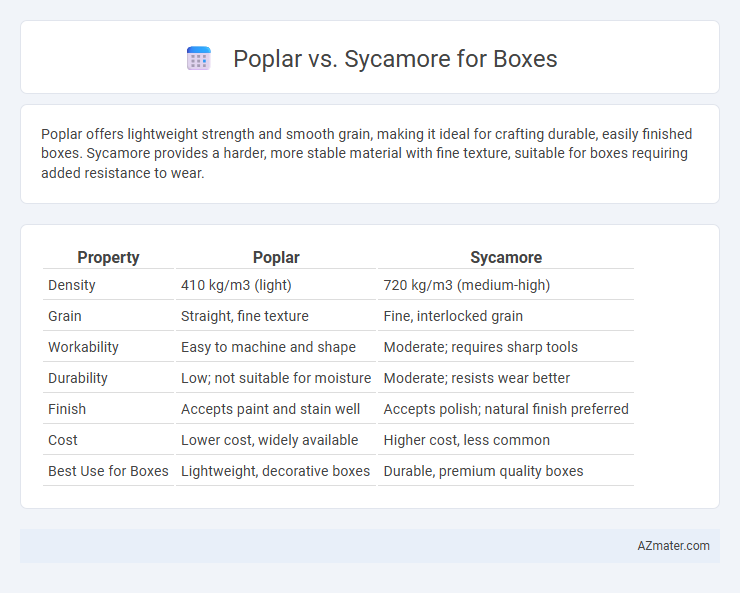Poplar offers lightweight strength and smooth grain, making it ideal for crafting durable, easily finished boxes. Sycamore provides a harder, more stable material with fine texture, suitable for boxes requiring added resistance to wear.
Table of Comparison
| Property | Poplar | Sycamore |
|---|---|---|
| Density | 410 kg/m3 (light) | 720 kg/m3 (medium-high) |
| Grain | Straight, fine texture | Fine, interlocked grain |
| Workability | Easy to machine and shape | Moderate; requires sharp tools |
| Durability | Low; not suitable for moisture | Moderate; resists wear better |
| Finish | Accepts paint and stain well | Accepts polish; natural finish preferred |
| Cost | Lower cost, widely available | Higher cost, less common |
| Best Use for Boxes | Lightweight, decorative boxes | Durable, premium quality boxes |
Introduction: Poplar vs Sycamore for Box Making
Poplar and sycamore are two popular wood choices in box making due to their distinct properties and availability. Poplar offers a lightweight, fine-grained texture with excellent workability, making it ideal for painted boxes and intricate detailing. Sycamore features a harder, dense grain with a pale cream color, providing durability and a smooth finish suited for natural or stained boxes.
Wood Properties: Comparing Poplar and Sycamore
Poplar wood is lightweight, soft, and easy to work with, making it ideal for carving and painting in box construction, while sycamore wood offers greater hardness and durability with a fine, even texture that resists warping. Poplar's straight grain and uniform pale green to light brown color provide smooth finishes but lack the strength of sycamore's interlocked grain and creamy-white to reddish-brown hues. For boxes requiring strength and longevity, sycamore outperforms poplar, which suits applications where ease of finishing and lower cost are priorities.
Grain Pattern and Aesthetics
Poplar wood features a fine, straight grain with a uniform texture, resulting in a smooth surface ideal for painted boxes and subtle designs. Sycamore exhibits a distinctive, wavy grain pattern with occasional flecks or curls, offering a more decorative and visually appealing appearance, perfect for natural finishes that highlight its character. The choice between poplar and sycamore depends on whether a clean, understated look or a bold, textured aesthetic is desired for the box.
Durability and Hardness
Poplar wood is generally softer and less durable than sycamore, with a Janka hardness rating around 540 compared to sycamore's approximately 770. Sycamore offers better resistance to wear and impact, making it more suitable for boxes requiring enhanced durability and structural integrity. Poplar's lighter hardness and lower durability make it more prone to dents and scratches in comparison.
Workability for Box Makers
Poplar offers superior workability compared to sycamore for box makers due to its softer texture and consistent grain, allowing for easier cutting, shaping, and sanding. Sycamore's interlocked grain and denser hardness can cause occasional challenges during precision joinery and surface finishing. Box makers often prefer poplar for intricate designs and faster production without compromising durability.
Cost and Availability
Poplar wood is generally more affordable and widely available than sycamore, making it a cost-effective choice for box construction projects. Sycamore tends to be pricier due to its limited supply and higher demand in specialty woodworking, often leading to longer lead times for procurement. Choosing poplar ensures easier sourcing and budget-friendly options without compromising moderate durability and workability.
Suitability for Finishing and Painting
Poplar wood offers a smooth, even grain that absorbs paint uniformly, making it highly suitable for finishes requiring a clean, professional look. Sycamore, with its interlocking grain and varied texture, may present challenges in achieving a flawless paint surface without thorough sanding and sealing. Box projects demanding consistent finish quality often benefit from poplar's predictable paint adhesion and minimal preparation needs.
Weight and Density Considerations
Poplar wood typically exhibits a lower density, ranging from 0.40 to 0.50 g/cm3, making it lighter and easier to handle compared to sycamore, which has a density between 0.55 and 0.75 g/cm3. This difference in weight and density significantly affects the choice for box construction, as lighter poplar is preferred for portability while denser sycamore offers enhanced durability and structural strength. Selecting between poplar and sycamore depends on the required balance between lightweight design and robustness for the intended box application.
Environmental Impact and Sustainability
Poplar wood offers a lower environmental impact due to its fast growth rate and high carbon sequestration capacity, making it a sustainable choice for box manufacturing. Sycamore, although slower-growing, provides durability and resistance to pests, potentially reducing the need for chemical treatments that can harm ecosystems. Choosing poplar or sycamore depends on balancing rapid renewability with long-term durability in sustainable box production.
Best Uses: Choosing Poplar or Sycamore for Your Box
Poplar offers a smooth texture and consistent grain, making it ideal for painted boxes or those requiring fine finishes, while sycamore provides a more distinct, wavy grain suitable for natural, decorative appearances. Sycamore's durability and resistance to wear make it preferable for storage boxes subjected to frequent handling, whereas poplar's lightweight nature benefits boxes intended for easy transport. Choosing between poplar and sycamore depends on the desired aesthetic, durability needs, and finishing preferences for your box project.

Infographic: Poplar vs Sycamore for Box
 azmater.com
azmater.com